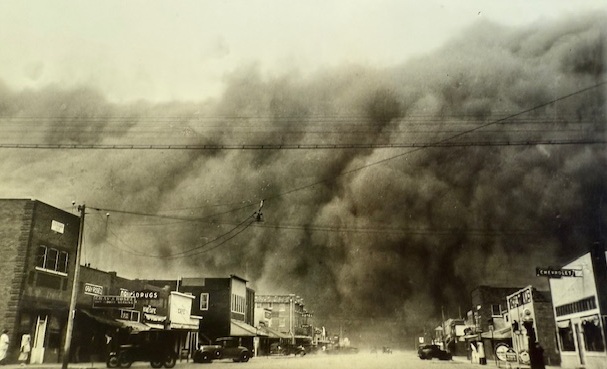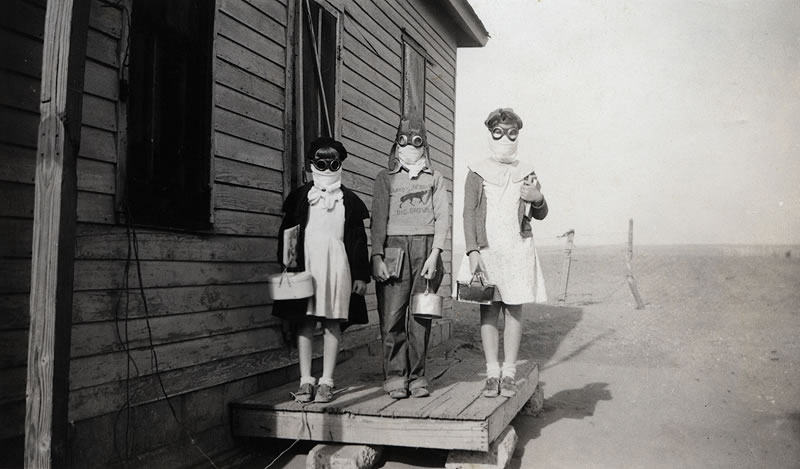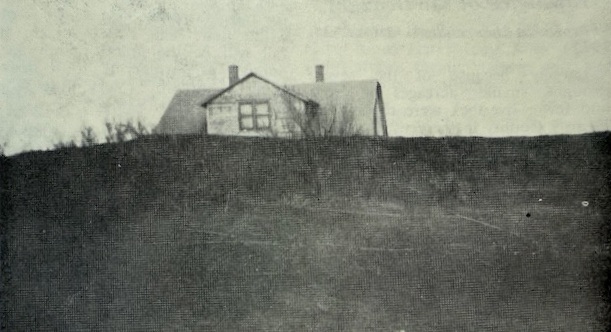April 14th marks the 90th anniversary of Black Sunday, the day that the Great Plains was struck by what was considered to be the worst dust storm of them all. It wasn’t the first dust storm that Kansans endured during the Dirty 30s, and it definitely wasn’t the last. Drought had ravaged the plains states since 1931. Little to no rain – together with poor soil conservation and overplowing – meant that when the typical high winds that are common in this area blew, they blew dirt. Eyewitnesses said one could tell where the dust storms originated by the color of the dust: black soil came from Kansas, red soil from Oklahoma and gray from Colorado and New Mexico. In all, it is estimated that 350 million tons of soil from Kansas, Texas and Oklahoma were deposited in eastern states.
Black Sunday started out mildly enough. The dust had settled out of the air, and it was a quiet afternoon with few clouds in the sky. Working on a farm south of Kendall, Howard Zook saw the rumbling wall of dirt approaching. “It just looked like a big solid bank rolling in,” said Zook. “When it hit the sun, the sun disappeared, and we beat it into the house. We stood there leaning against the wall. The only way you knew where people were was by feel. We could reach out and hit ‘em. You couldn’t see ‘em a foot away from ya. The dirt was just that thick.”

John Grusing and his sons were working a mile northwest of their home in northern Kearny County when the storm hit. “We couldn’t see the road or anything at all. We didn’t know where to turn south or where we were after we turned south. Then we came to a fence,” he recalled. “I knew my own fences so we felt of the wires … knowing the fence west of the house was a two-wire and the fence north was a three-wire, I could tell where we were. Every joint in the fence sparked with electricity. The fence was a three-wire fence and by that we knew how to follow it to the house. There were lights on in the house, but we couldn’t see the lights from the windows as the dust was so dense. But we knew now where we were and finally felt our way to the door.”
The Lakin Independent reported, “A spectacular dust storm came over us Sunday afternoon from the north, and within two minutes the country was plunged into dense midnight darkness. It was impossible to see a hand before your face or to drive a car into the garage. Ernest White was out on horseback and unable to see the horse he was riding. After a half hour the atmosphere cleared a little, but the storm kept on, and lamps were needed the rest of the day.”
Hannah Rosebrook lived in the Fairview Community near the Wichita County line and wrote a weekly column for The Independent. In the April 19th issue, she said, “Still we are fighting dirt. Not a minute’s let-up since Sunday at 1:00 p.m.”

The Black Sunday storm was estimated to be 500 to 600 feet in height, moved at a rate of 50 to 60 mph, and covered approximately 800 miles. Some wind gusts reached up to 100 miles per hour. The temperature dropped 25 degrees per hour, and more than 300,000 tons of soil blew away. That is twice as much dirt as was dug out of the Panama Canal. It was after the Black Sunday storm that Robert Geiger, an Associated Press reporter, coined the phrase, “Dust Bowl.”
Meteorologists rate the Dust Bowl as the #1 weather event of the 20th Century. The first notable dust storm with winds reaching 60 mph was documented on Sept. 14, 1931, and the weather bureau reported 14 bad dust storms the following year. By 1933, the number had increased to 38. During March and April of 1935, about 4.7 tons of dust per acre fell on western Kansas during each dirt blizzard. In 1937, a high of 72 storms marked a peak in the Dust Bowl era. Rosebrook reported not seeing the sun from Saturday until Wednesday noon during one of the severest periods in February of 1937.
The Independent described the dirt as, “fine, penetrating dust that fills the air like driven snow; stifling, blinding, it comes in through every crack and crevice and fills the whole house with silt, and piles up in drifts beside buildings and in sheltered places as it blows and swirls through town and country.” Those who inhaled the dust suffered coughing spasms, shortness of breath, asthma, bronchitis and influenza. Hundreds died from dust pneumonia, also known as the ‘brown plague.’ Infants, children and the elderly were especially susceptible. The Red Cross set up emergency hospitals in the Dust Bowl states and handed out 17,000 gauze masks, but it could take less than an hour exposure outside to darken one of the masks.
Livestock also suffered. Lack of feed reduced them to weakened conditions, and many were unable to stand the black blizzards. Some drifted with the storms and starved before being found while others smothered. Dust buried buildings, shrubs, farm fences and machinery. Tourists were unable to further their journeys and took refuge wherever they could. Trains were stopped in their tracks, and dust storm “holidays” were declared for students.

Complicated by the Great Depression, overpopulation of jackrabbits and hordes of grasshoppers, conditions continued to deteriorate on the Great Plains. By 1940, 2.5 million people had left the area, at least 300,000 traveling to California in what was considered the largest single migration in U.S. history. Approximately 250,000 boys and girls became hobos.
Several national programs such as the Civilian Conservation Corps and Soil Conservation Service were born to combat the effects of not only the crippling dust storms but the drowning economy as well. Men were put back to work through programs like the Works Progress Administration and Public Works Administration which led to the construction of the Kendall bridge, Menno Community building and the Kearny County courthouse. Still others were employed on conservation projects like planting tree rows or shelterbelts. Causes for the Dust Bowl were carefully studied, and new agricultural methods were encouraged such as terracing, contour farming, crop rotation, strip farming and planting ground cover.
The drought and its associated impacts finally began to subside in the spring of 1938, and by 1941, most areas of the country were receiving near-normal rainfalls. These rains, along with the outbreak of World War II, alleviated many of the domestic economic problems of the preceding decade. Drought returned in the 1950s, and from 1954-1957, twice as many acres in the Great Plains were damaged annually by wind erosion as from 1934-1937. Improved farming techniques and equipment, soil conservation, and irrigation saved the area and its people from a repeat of the Dirty ‘30s.
SOURCES: National Weather Service; National Drought Mitigation Center; Kinsley Public Library; “Dust Bowl” by Donald Worster; “Ethnic Heritage Studies: The Fairview News”; History of Kearny County Vol. II; Archives of the Lakin Independent; Hutchinson News, and Southwest Kansas Senior Beacon; and Museum archives.
